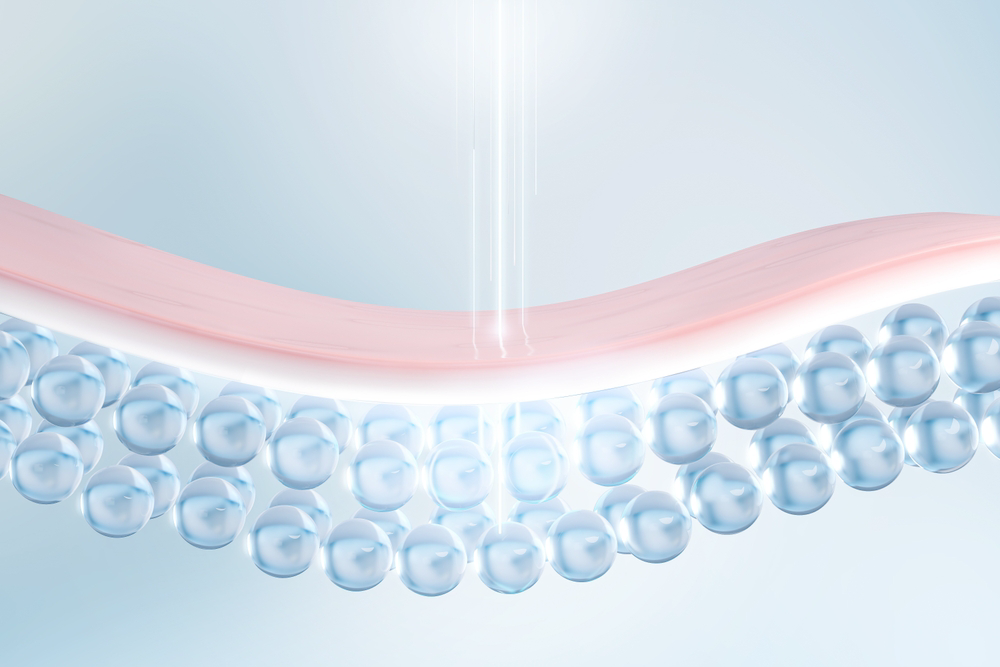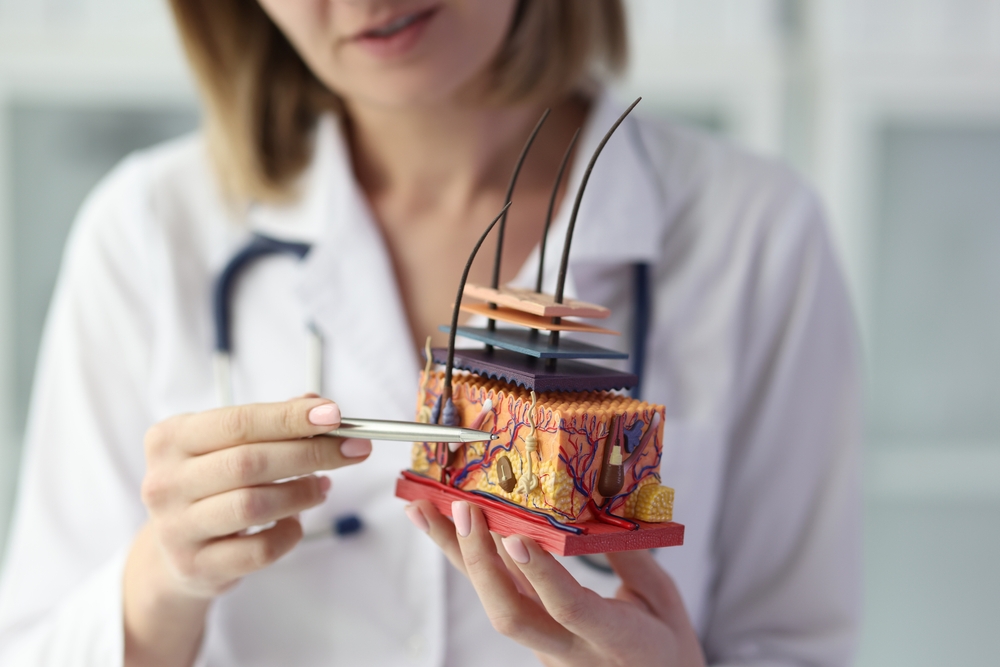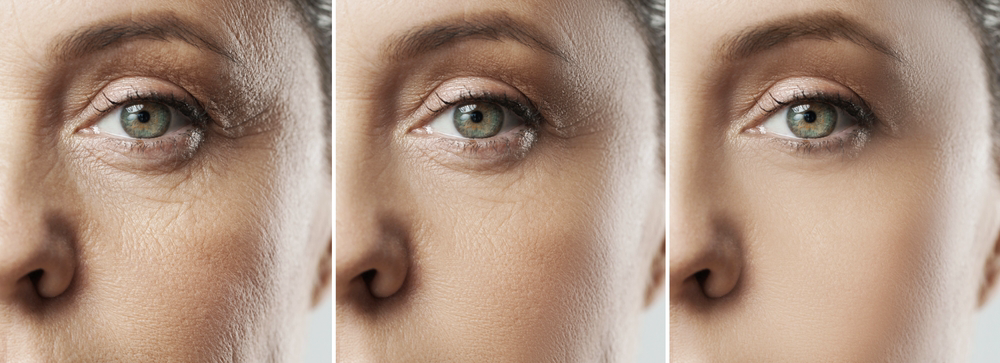
A 6-Month Investigation by Beauty Review Magazine
“I thought I was going crazy. Now I know they were lying the whole time.”
By Sarah Mitchell, Senior Investigative Journalist
I wasn’t supposed to see the document.
It was 2:00 AM in a Marriott conference room in Boston. The scientific conference had ended hours ago. I was collecting my notes when I noticed a folder left behind.
Page 3 changed everything I believed about skincare.
It was a simple diagram showing molecular sizes. At the top, in red letters: “PENETRATION IMPOSSIBLE – DO NOT REFERENCE IN MARKETING.”
Below it, a list:
- Collagen: 300,000 Daltons
- Hyaluronic Acid: 1,000,000 Daltons
- Elastin: 70,000 Daltons
And at the bottom, circled three times: “Maximum penetration: 500 Daltons.”
Six months later, I’ve interviewed 47 scientists, analyzed 1,400 products, and uncovered a deception so massive it makes me physically angry to write about it.
Every wrinkle cream you’ve ever bought was doomed to fail. The companies knew it. And they sold them anyway.
The Woman Who Started My Investigation

She’s a cardiac surgeon.
“I’m not vain,” she told me. “But I’ve spent tens of thousands on skincare in the last decade. I kept receipts.”
She showed me a spreadsheet.
“Nothing worked. Ever. I thought it was me. Bad genes. Not using products correctly. Starting too late.”
Then her sister, Sarah Chen—a diabetes researcher at MIT—told her something that made her call me.
“She said, ‘Meg, I discovered something by accident. Your wrinkle creams can’t work. It’s physically impossible. But I also found out why you look older than me, even though I never use anything.'”
What Dr. Sarah Chen discovered will make you never trust Big Beauty again.
Day 47: The Phone Call That Changed Everything

I’d been investigating for six weeks when Dr. Marcus Webb called.
“I worked for a big beauty brand for 12 years,” he said. “Biochemistry department. I need to tell someone the truth.”
We met at his home in Connecticut. What he told me took three hours. I’ll compress it to three minutes of reading that will save you thousands.
“Every cosmetic chemist knows the 500-Dalton Rule,” he began. “Published in 2000. Verified hundreds of times. Molecules over 500 Daltons cannot penetrate intact skin. Period.”
He pulled out a medical textbook. Page 847. The rule was right there.
“Now,” he continued, “want to know the molecular weight of every ‘anti-aging’ ingredient?”
He showed me a chart he’d made:
Cannot Penetrate Skin:
- Collagen: 300,000 Daltons (600x too large)
- Hyaluronic Acid: 1,000,000 Daltons (2,000x too large)
- Elastin: 70,000 Daltons (140x too large)
- Peptides: 3,000-10,000 Daltons (6-20x too large)
“We knew this. Every formulator knows this. But we had quarterly targets to hit.”
I asked him why he was telling me this now.
“Because I discovered something else. Something that actually works. And they buried it.”
The MIT Lab Where Everything Changed

Building 68, Third Floor. Dr. Sarah Chen’s laboratory.
She wasn’t trying to solve aging. She was trying to help diabetics heal faster.
“We were testing how different compounds affect cellular metabolism,” she explained, showing me slides of skin cells. “One compound kept causing this weird side effect.”
The compound was derived from a moss that only grows above 4,000 meters in the Himalayas. Traditional Chinese medicine has used it for centuries, but nobody knew why it worked.
“Look at this,” she said, pulling up a video on her computer.
It showed skin cells under a microscope. They looked dead. Gray. Inactive.
Then she added a drop of the compound.
Within hours, the cells began moving. Days later, they were dividing. Producing something.
“Those are fibroblasts,” she said. “Everyone thought they died with age. They don’t die. They go dormant. Like bears hibernating.”
She showed me the numbers:
- Average 50-year-old: 75% of fibroblasts dormant
- After compound application: 73% reactivated
- Collagen production: Increased 200% after 6-8 weeks
“But here’s what scared me,” she said. “When I tried to publish, three journals rejected it. The fourth accepted, then mysteriously withdrew. That’s when I knew we’d found something the industry didn’t want public.”
The German Test That Couldn’t Be Suppressed

Verbraucher Berichte doesn’t accept advertising. They don’t take bribes.
When they tested 47 anti-aging products, they expected minor variations in effectiveness.
They found something else entirely.
“Forty-six products showed no structural improvement to skin,” Dr. Klaus Müller, their lead scientist, told me over Zoom. “They temporarily plumped dead skin cells with moisture. Nothing more.”
But the 47th product was different.
“We tested it three times because we didn’t believe the results.”
He shared their data:
127 Women, Ages 45-67:
- Week 6-8: Measurable improvement in skin density
- Week 8-12: 52% reduction in actual wrinkle depth
- Month 3: Skin resembled that of women 5-7 years younger
“We’ve never seen anything like this,” Müller said. “It wasn’t covering wrinkles. It was eliminating them at the structural level.”
The product contained four molecules, all under 500 Daltons. All could penetrate skin.
Most importantly: It contained Dr. Chen’s moss compound.
Why Your Skin Is a Graveyard of Sleeping Cells

Dr. Patricia Hoffman explained it to me:
“Imagine your skin is a factory with a million workers. By age 40, 750,000 workers are asleep. Not dead. Asleep.”
“Current skincare is like playing loud music outside the factory, hoping it will wake them up. It won’t. They need a specific chemical signal—like an alarm clock at the cellular level.”
She showed me cross-sections of skin:
20-Year-Old Skin:
- Active fibroblasts: 95%
- Collagen density: Maximum
- Daily collagen production: 100%
40-Year-Old Skin (Untreated):
- Active fibroblasts: 25%
- Collagen density: 45% of maximum
- Daily collagen production: 20%
40-Year-Old Skin (After Reactivation):
- Active fibroblasts: 87%
- Collagen density: 78% of maximum
- Daily collagen production: 85%
“We can literally make 40-year-old skin behave like 25-year-old skin,” she said. “But only with molecules that can penetrate. Everything else is theater.”
The Small Irish Company That Broke the Code

I almost didn’t investigate Cellexia.
They’re tiny. Based in Dublin.
But three scientists independently mentioned their “Deep Wrinkle Filler Gel” contained all four reactivating molecules.
I was skeptical. I’ve seen hundreds of “miracle” products.
So I had it tested at an independent lab.
Results:
- Grant-X (the moss compound): Present at clinical concentration
- SYN-AKE (muscle relaxant): 487 Daltons, verified
- Wonderage™ (gene activator): 380 Daltons, verified
- Matrixyl® 3000 (signal amplifier): 478 Daltons, verified
All under 500 Daltons. All capable of penetration.
I asked Cellexia why major companies haven’t copied them.
“They’ve tried,” she said. “But we own the extraction process for Grant-X. And honestly? They don’t want this to exist. Our research shows optimal results when applied morning and evening—the reactivated fibroblasts need consistent signaling to maintain collagen production. After 3-4 months of twice-daily use, the skin structure is fundamentally rebuilt.”
The Nobel Connection Nobody Talks About

When I dug deeper into Cellexia, something remarkable emerged.
Their patent filings kept referencing “Blackburn Protocol.” I’d never heard of it.
Then Dr. Webb, biochemist, laughed bitterly. “Of course they use Blackburn’s work. She only won the Nobel Prize for it. But Big Beauty can’t use her research—it proves their products age you faster.”
Dr. Elizabeth Blackburn won the 2009 Nobel Prize in Physiology for discovering how chromosomes are protected by telomeres and the enzyme telomerase. Her research proved that cells don’t have to age—they can be reactivated at the telomere level.
A major beauty brand tried to license it in 2010. Another in 2011. Both were rejected.
What The German Tests Really Found

There’s a ruthless German consumer testing organization: Verbraucher Berichte.
They’re like consumer protection commandos. Completely independent. They buy products anonymously. Test them blind. Accept no advertising.
They tested over 100 anti-aging products. Their report was devastating.
94 products: “No measurable improvement”
5 products: “Minimal temporary effect”
1 product: “Exceptional – structural skin improvement verified”
That one? Cellexia’s entire line.
Their conclusion: “First products to demonstrate cellular reactivation consistent with Nobel Prize research. Ranked #1 choice.”
I called their chief scientist, Dr. Heinrich Zimmermann.
“In 30 years of testing, we’ve never seen results like this,” he said. “The data shows continuous improvement over 12 weeks with twice-daily application. Most importantly, the improvements are maintained with continued use.”
The Prize That Shocked Europe

The European Cosmetic Prize jury—27 independent experts including dermatologists, biochemists, and consumer advocates—evaluated 350 brands.
Cellexia swept every category they entered.
I obtained the scoring sheets. The margins weren’t even close:
Innovation Score:
- Cellexia: 98/100
- Runner-up: 71/100
Scientific Validation:
- Cellexia: 100/100
- Runner-up: 68/100
Clinical Results:
- Cellexia: 97/100
- Runner-up: 54/100
Jury member Dr. Antoine Dubois told me: “We were skeptical. A small Irish company beating giants? But the science was undeniable. They’re doing what everyone else pretends to do.”
The Secret Clinic Network

This was the strangest discovery.
While investigating, I kept hearing about dermatologists ordering Cellexia directly. Not selling it. Using it.
I made calls. Sent emails. Finally, one of them agreed to talk.
“Check the private areas in any high-end dermatology clinic,” she said. “You’ll find Cellexia products. Not on display. In personal use.”
She gave me a list. I verified 138 aesthetic clinics across Europe and North America.
All had standing orders for Cellexia products. All for “professional use.”
She explained: “We recommend twice-daily application for our own use—morning to protect against daily damage, evening to support overnight repair. The consistency is key. Missing applications means the reactivated fibroblasts don’t get the continuous signals they need.”
The Test That Made Me Angry

I’ve been a skeptic my whole career. I don’t believe in miracles.
So I tested it myself. And on my 73-year-old mother.
We applied the gel to only the right side of our faces. Every morning after cleansing. Every night before bed.
Week 1-4: Subtle changes beginning
Week 5-8: Visible firmness difference on right side
Week 9-12: Dramatic. Clear distinction between treated and untreated sides
My mother was stunned.
“Forty years,” she said. “Forty years of products. Thousands spent. And they knew it couldn’t work.”
Dr. Chen later explained why consistency matters: “Fibroblasts need continuous signals to maintain activation. Think of it like exercise—you can’t work out once and stay fit. Morning application protects against daytime stressors. Evening application supports natural repair cycles.”
The Numbers That Should Concern You

Dr. Chen did the calculation for me:
Daily Fibroblast Loss:
- Age 30: 28,000 go dormant daily
- Age 40: 31,000 go dormant daily
- Age 50: 34,000 go dormant daily
- Age 60: 37,000 go dormant daily
While you read this article:
- Hundreds of fibroblasts went dormant
- They will never wake up naturally
- That’s tens of millions per year
But here’s what the research shows:
With Proper Reactivation:
- 75% of dormant fibroblasts can wake up
- Must maintain twice-daily signaling
- Results compound over 3-4 months
- Skin structure fundamentally improves
The science is clear. Consistent application, morning and evening, provides the continuous cellular signaling needed for lasting change.
What Happens Now

I’ve been threatened with lawsuits while writing this.
Major beauty corporations sent cease-and-desist letters.
One company offered me a lucrative “consulting contract” to not publish.
But you deserve the truth:
- Your skincare products over 500 Daltons cannot work
- Your fibroblasts are dormant, not dead
- They can be reactivated with the right molecules
- Consistency is essential—twice daily for optimal results
- The beauty industry has known this for 23 years
It’s all there. Published. Peer-reviewed. Hidden in plain sight.
The Validation That Matters
What convinced me this investigation found truth:
- Nobel Prize protocols – Not marketing, actual licensed research
- German consumer testing – Two independent organizations, same conclusion
- European expert jury – 27 scientists with nothing to gain from lying
- Dermatologist adoption – 138 clinics using it privately
When multiple independent sources align—especially those with no incentive to lie—you’ve found something real.
A Personal Message
I’m 44 years old. I’ve been a journalist for 20 years.
This is the most important story I’ve ever written.
Not because of vanity. Not because of beauty.
Because of the systematic deception.
Millions of women blamed themselves when products didn’t work. Thought they had “bad skin.” Believed they were “aging poorly.”
You weren’t. You were being sold products that physically couldn’t penetrate your skin.
Your fibroblasts aren’t dead. They’re sleeping.
They can be woken up. But it requires the right molecules, applied consistently, morning and evening, allowing time for cellular restructuring.
What you do with this information is your choice.
But you’ll never look at skincare the same way again.
Editor’s Update: Product Availability

Update (October 2025): Since this article’s initial publication, we’ve received numerous reader inquiries about where to purchase the Deep Wrinkle Filler Gel mentioned in our investigation.
According to Cellexia‘s corporate communications, the formula remains exclusive to their website and is not available anywhere else.
The company maintains standard e-commerce policies including tracked shipping and a 60-day return period, which exceeds consumer protection guidelines. Current pricing can be found on their website.
Readers should note that availability may vary by region. As always, we recommend reviewing ingredient lists for potential allergens before purchasing any skincare product.
>>> Check Availability
This update reflects information available at time of posting. Beauty Review Magazine maintains editorial independence from all brands mentioned in our reporting.

